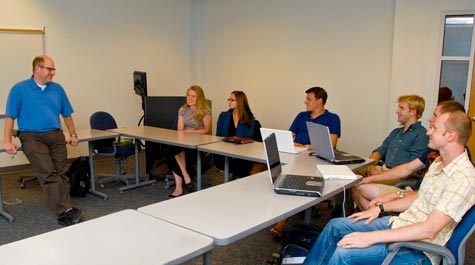Guilty Until Proven Innocent
Against tough odds, the W&M Innocence Clinic offers hope for the wrongfully convincted.
In 1977, Paul Terry was sentenced to 400 years in prison for multiple murder, rape and kidnapping convictions. After serving 26 years of hard time, a team of lawyers associated with the Innocence Project in Chicago uncovered DNA evidence that fully exonerated Terry of any wrongdoing.
Innocence Projects throughout the country have been responsible for more than 200 exonerations like Terry's, and William &Mary Law School has joined the fight. In 2006, W&M law students founded a student chapter of the Innocence Project and quickly petitioned to add a full-credit Innocence Clinic to the course offerings.
The clinic, run by Richmond-based attorney Fred Gerson '96, represents a last chance for justice for wrongfully convicted people. Students spend the semester digging through boxes and boxes of case materials provided by the Mid-Atlantic Innocence Project (MAIP). The hope is that some scrap of paper, some long-buried piece of evidence, will be the key to reversing a conviction.
"It was inspiring," says Franklin Turner '08, who was involved in the Innocence Clinic as a 3L. "It was like an episode of Law & Order."
At the end of the clinic, Turner and his classmates working on a case were thrilled to find a needle of hope in a haystack of 30-year-old court records, witness testimonies and police reports.
"We found out that [our client] has an IQ of about 60. And that was buried in 500 pages of stuff," says Turner, adding that a low IQ should have raised questions about the validity of his client's confession. When the law students are done compiling their evidence, it goes back to MAIP for further review. If there's enough to go on, MAIP reopens the case and recruits pro bono counsel.
Gerson was fresh out of W&M when he and fellow attorney Steve Northup began working to exonerate Beverly Monroe of the highly publicized murder of her long-time partner. The effort to win her release took seven years and was especially difficult since there was no DNA evidence. Gerson and Northup had to prove that not only was her "confession" bogus, but that her partner committed suicide. "That's what you have to do in these cases," says Gerson. "You have to prove beyond a shadow of a doubt that the guy or gal is innocent."
Monroe became involved with the Law School's student chapter of the Innocence Project and recommended Gerson to lead the clinic. Gerson calls clinical work "phenomenally important" for law students.
It's hands-on practical experience," he says. "They deal with clients. They deal with witnesses. They deal with government officials. They deal with third parties."
Turner agrees, calling the clinic a welcome injection of real-world experience in an academic environment ruled by hypotheticals. The work is so labor intensive, however, that it will take much more than one semester to make a case for exoneration.
The work lives on," says Turner. "The next group comes and picks up where we left off."
